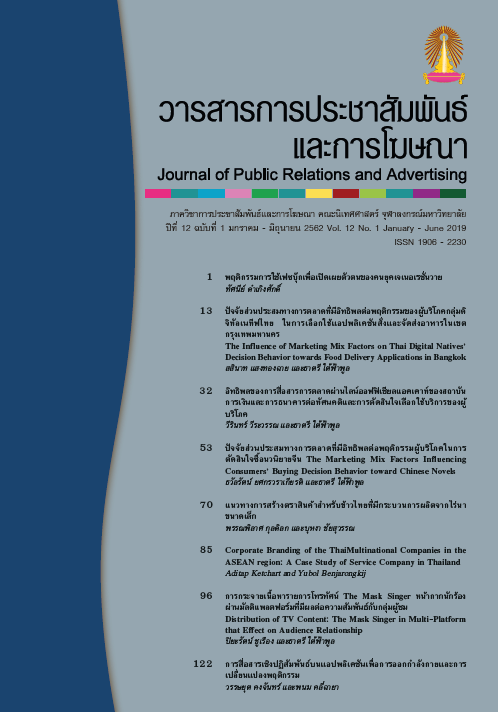Branding Approaches for Thai Rice from Small-scaled Farming
Main Article Content
Abstract
The aim of this research is to study Thai rice branding approaches which is processed by a production of small – scale farms. An in-depth interview and focus group have been applied to successful rice brand developers, branding experts, and relevant public and private authorities. Consumer focus group is also used. The result shows that branding approaches consist of 6 steps as follows: 1) Systematically internal and external factor analysis 2) Rice brand identity and positioning in accordance with consumer preferences yet distinctly different from others 3) Tangible and intangible rice brand element development in accordance with brand positioning 4) Plan and activity to present rice brand elements 5) Regular performance assessment 6) Sustainable brand equity growth through constant brand maintenance together with brand element changes to meet the particular contexts.
Article Details
References
จุฑาทิพย์ ภัทรวาท. (2559). นักวิชาการกะเทาะปัญหาโครงสร้างชาวนาไทย ทำนาแล้วไม่ได้นา. สืบค้นเมื่อ 31 มกราคม 2560, จาก http://www.qlf.or.th
เดชรัต สุขกำเนิด. (2559). “ลูกชาวนา ได้เวลาช่วยพ่อ” ระดมสมองแก้ราคาข้าวตกต่ำ. คมชัดลึก. สืบค้นเมื่อ 2 มกราคม 2560, จาก http://www.komchadluek.net
ทศพล หงส์ทอง. (2559). ยกระดับข้าวอาเซียน สู่ยุคเกษตรกรรม 4.0. สืบค้นเมื่อ 2 มกราคม 2560, จาก http://www.posttoday.com/biz/aec/scoop/446978
ธนณฐ์วรรธ์ แสงหวัง และคณะ. (2554). โครงการวิจัยเครือข่ายคุณค่าข้าวหอมมะลิสหกรณ์ไทยแบรนด์ข้าวเกิดบุญ. รายงานวิจัยฉบับสมบูรณ์. สานักงานกองทุนสนับสนุนการวิจัย.
วิลาศ วิชญะเดชา. (2558). แนวทางการพัฒนาให้ไทยเป็นศูนย์กลางการค้าเมล็ดพันธุ์ข้าวในอาเซียน.รายงานการศึกษาส่วนบุคคล. สถาบันการต่างประเทศเทวะวงศ์วโรปการ กระทรวงการต่างประเทศ.
สุทธิกร กิ่งแก้ว. (2559). มธ.เปิดพื้นที่ให้ชาวนาขายข้าวตรงสู่ผู้บริโภค. สืบค้นเมื่อ 2 มกราคม 2560, จาก http://www.bangkokbiznews.com
สุภรัตน์ ปัดภัย. (2552). กลยุทธ์การตลาดธุรกิจข้าวอินทรีย์ของกลุ่มเกษตรกรรมยั่งยืน ตำบลน้ำอ้อม อำเภอค้อวัง จังหวัดยโสธร. วิทยานิพนธ์มหาบัณฑิต. สาขาวิชาการจัดการทั่วไป. มหาวิทยาลัยราชภัฏอุบลราชธานี.
อภิรดี ตันตราภรณ์. (2559). ถึงเวลารัฐบาล ปฏิรูปชาวนาไทย แก้ปัญหาราคาข้าวตกต่ำซ้ำซาก. มติชนสุดสัปดาห์. สืบค้นเมื่อ 2 มกราคม 2560, จาก https://www.matichonweekly.com
อัทธ์ พิศาลวานิช. (2557). อึ้ง! ชาวนาไทยจนสุดในอาเซียน ส่งออกข้าวร่วงมาอยู่อันดับ 3. สืบค้นเมื่อ 30 พฤศจิกายน 2559, จาก http://news.mthai.com/economy-news/313039.html
อารีวรรณ คูสันเทียะ. (2559). ความสำเร็จการรวมกลุ่มชาวนาญี่ปุ่น บทสะท้อนสู่ชาวนาไทย. สืบค้นเมื่อ 5 มกราคม 2560, จาก http://www.landactionthai.org
Aaker, D. A. (1996).Measuring Brand Equity across Products and Markets. California management review, 38(3), 102-120.
Aaker, D., A.,,& Erich, J. (2000). Brand Leadership. London: Free Press.
Aaker, D. A. (2009).Managing Brand Equity. UK: Simon and Schuster.
Abdullahi, F., A., ,Zainalabidin, M., &Isalami, A. L. (2011). The Influence of Socio- demographic Factors and Product Attributes on Attitudes toward Purchasing Special Rice among Malaysian Consumers. International Food Research Journal, 18(3), 1135-1142.
AzabagaogluM.O.,&Gaytancioglu O. (2009). Analyzing Consumer Preference to Different Rice Varieties in Turkey. Agricultura Tropica Et Subtropica, 42(3), 118 – 125.
Bradley, J. R., Todd, M. S., Miguel, L. G., &Hao, L. (2011). Does the Name Matter? Developing Markets for New Managed Apple Varieties. New York Fruit, 3(-), 5-9.
Davis S. M. (2002). Brand Asset Management: How Business can Profit from the Power of Brand. Journal of Consumer Marketing, 19(4), 351-358.
Fernández-Barcala, M., & González-Díaz, M. (2006). Brand Equity in the European Fruit and Vegetable Sector: A Transaction Cost Approach. International Journal of Research in Marketing, 23(1), 31-44.
Gerlach, A., & Witt, J. (2012). Sustainability in the Context of Strategic Brand Management: A Multiple Case Study on the Automobile industry. (Master of Science), Halmstad University.
Hoang, T. P., Chi, T. T. H., Linh, N. C. H., &Quang, H. T. (2016). Factors Affecting the Sustainable Development to Vietnamese Rice Brands in Joining TPP Agreement: A Study in Ho Chi Minh City, Vietnam. European Journal of Business and Social Sciences, 4(11), 41-52.
Keller, K. L. (1993). Conceptualizing, Measuring, and Managing Customer-based Brand Equity.the Journal of Marketing, 57(1), 1-22.
Keller, K. L., Apéria, T., &Georgson, M. (2008). Strategic Brand Management: A European Perspective. US: Prentice Hall Financial Times.
Keller, K. L., Parameswaran, M., & Jacob, I. (2011). Strategic Brand Management: Building, Measuring, and Managing Brand Equity. India: Pearson Education
Lim, K. Y., Mohamed, R., Ariffin, A., & Guan, G. (2009). Branding an Airline: A Case Study of Air Asia. Malaysian Journal of Media Studies, 11(1), 35-48.
Musa, M., Othman, N., & Fatah, F. A. (2011). Determinants of Consumers Purchasing Behavior for Rice in Malaysia. American International Journal of Contemporary Research, 1(3), 159-167.
Nijssen, E. J., & Van Trijp, H. C. (1998). Branding Fresh Food Products: Exploratory Empirical Evidence from the Netherlands. European Review of Agricultural Economics, 25(2), 228-242.
Nkari, I., Micheni. (2015). Branding Practices for Fresh Fruits and Vegetables. (Master of Business Administration), University of Nairob.
Urde, M. (1999). Brand Orientation: A Mindset for Building Brands into Strategic Resources. Journal of marketing management, 15(1-3), 117-133.
Utami, H. N., Sadeli, A. H., &Perdana, T. (2016). Customer Value Creation of Fresh Tomatoes Through Branding and Packaging as Customer Perceived Quality. International Society for Southeast Asian Agricultural Sciences–Philippines, 22, 123-136.


